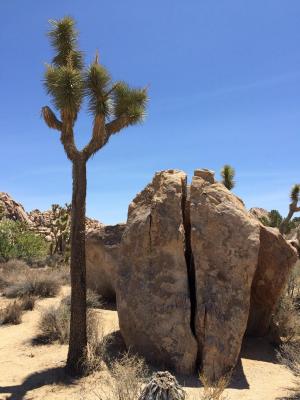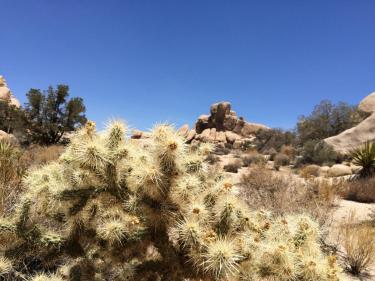The north edge of the Coachella Valley is dominated by Joshua Tree National Park. Only a full-fledged national park since 1994, it has been preserved as a national monument since 1936. The park occupies a bit more than 1,200 square miles of California desert, making it slightly larger than the state of Rhode Island.
Joshua Tree National Park gets its name from the Joshua trees that are native to the Mojave Desert and common across the landscape. These distinctive trees are also known as yucca palms, tree yuccas, and (to cover all bases) palm tree yuccas. Mid 19th-century Mormon settlers named them “Joshua Trees” because (as the story goes) the branches reminded them of Joshua reaching up to heaven in prayer (we suspect those imaginative settlers were delirious from the desert heat). Joshua trees have been used for fencing and for fuel.
We spent a solid day exploring Joshua Tree National Park, entering the park at its West Entrance Station, and traversing it to exit at the southerly Cottonwood Spring exit. It was mild the day we visited—never hotter than the mid 90’s—notably cooler than down in the valley. Joshua Tree National Park is a noticeable blend of two distinct “high” deserts: the Mojave Desert and the Colorado Desert. If you find yourself in Joshua Tree National Park, here are the three don’t-miss sights we recommend.

A Joshua Tree and a Perfectly Split Boulder at Hidden Valley
Hidden Valley – a nice picnic area with restrooms, accessibility to an easy and manageable nature trail, and some interesting history make this a great place to spend some time. A narrow gap in the rocks leads into a small, 55-acre valley that, as the name implies, is nicely hidden from the surrounding landscape. It was the ideal place for the McHaney Gang to hide stolen cattle in the 1870’s. Today, a 1-mile trail takes you around the edge of the valley for some great pictures of rock formations, cactus, vistas, and (of course) Joshua trees.

Commanding View of the Coachella Valley from Keys View
Keys View – no better place will remind you that you are in a “high” desert at Joshua Tree National Park than Keys View. This overlook offers a stunning view of the Coachella Valley. On a very clear day like we had, you can see all the way to Mexico. What gave us pause was the sign with a map showing that the San Andreas fault runs through the center of the Coachella Valley. You can actually see where the fault is by the effect it has on the landscape.

Cholla Cactus at the Cactus Garden
Cholla Cactus Garden – on the way to the park’s southern exit (on the way to the Cottonwood Visitor’s Center from other parts of the park), you’ll pass a splendid little spot called the Cholla Cactus Garden. You’ll notice these unique cacti long before you come to the garden (they’re pronounced “choy-yah”). They are a small, spiny cactus with deceptively soft-looking barbs: they almost seem to dare you to touch them, but they are tenaciously barbed, hard to get out of your clothing and skin. It’s best to admire them from a comfortable distance and with camera in hand.

Cactus Garden at Joshua Tree National Park






